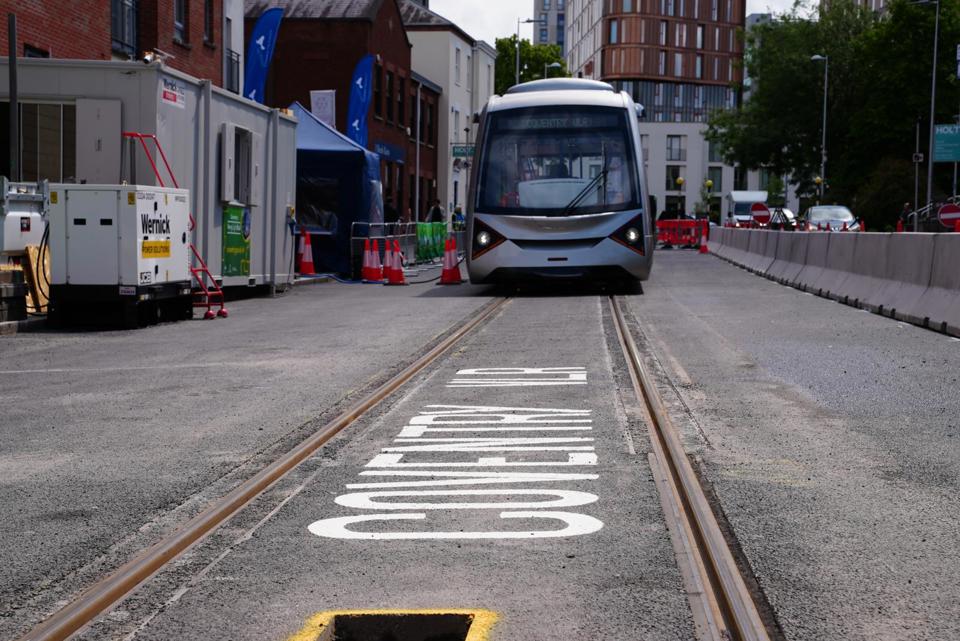The concept of Very Light Rail has been slow to mature, but a system being developed in Coventry is offering plenty of promise. Peter Plisner reports.
Plans for a Very Light Rail scheme in Coventry have been around for several years. But so far, apart from a prototype vehicle and the development of a special type of track, little has happened.
The concept of Very Light Rail has been slow to mature, but a system being developed in Coventry is offering plenty of promise. Peter Plisner reports.
Plans for a Very Light Rail scheme in Coventry have been around for several years. But so far, apart from a prototype vehicle and the development of a special type of track, little has happened.
However, things are about to change, following the installation in the city centre of a test track which will allow passengers to experience what planners say will help lead to a revolution in transport in the city.
It’s the latest stage in a lengthy process that has taken much longer than anyone ever imagined.
The original plan was to have a route from the railway station to the city centre up and running by now.
A vehicle was designed and tested at Dudley’s Very Light Rail National Innovation Centre, and a special ‘slab-track’ was developed by engineering specialist WMG at the University of Warwick, in partnership with Ingerop.
The revolutionary track would only need to be installed with a trench dug to a depth of around 30cm, rather than the 50cm-80cm that is often required for traditional light rail.
The theory is that not digging so deep negates the need to divert all utilities and other services. That, in addition to the smaller and more lightweight vehicle, would at least halve costs compared with traditional light rail.
But even with the promise of drastic savings, cash for the scheme hasn’t exactly been overflowing. The project has also been plagued by funding issues and the need to jump through many legislative hoops.
The Labour-run council has been critical of the time it’s taken to get the scheme off the ground.
Jim O’Boyle, Cabinet Member for Jobs, Regeneration and Climate Change at Coventry City Council, says: “It’s probably a good example of why this country is lagging behind so much, when it comes to economic growth, when it comes to making decisions about investing in new technology and industrialising some of our great inventions. It’s new and innovative, and it’s done here in this country.”
But that’s what O’Boyle feels has led to the delay in getting the scheme up and running.
“Experts are nervous, because they don’t understand it and they don’t believe in it because they’ve never heard of it.
“The second thing to say is that it is technical, and because of that the legislation and the processes to go through in order to prove the concept is tedious beyond belief and incredibly time-consuming.”
Nicola Small, VLR Programme Director at the council, agrees that the lack of funding has been a major issue: “If you’ve got money, you can do anything. You can build a big enough team and solve all the problems. And you can throw big resources at the project.
“There’s a lot of documentation that has to support the products that we’ve developed.
“We know what we’ve done is game-changing. We know it has the potential to be transformative. We’ve had to go on a journey, and we’ve had to bring people on that journey with us.”
Another selling point for the transformative technology is the components used, which have been shared with the automotive industry - again helping to reduce costs.
The use of composites helps with lightweighting across the vehicle. But the biggest application is around how the bogie is configured, which has resulted in Coventry City Council securing patents.
However, the use of automotive components has led to a host of other issues.
Small says: “We’ve used lightweight materials that we’ve got from the automotive sector. But what we’re finding now is that there are certain rail regulations that are non-negotiable.
“The emergency stop, for instance - the vehicle has to stop as fast as a tram with compliant systems, so we’re doing modifications to make sure it complies with the non-negotiable requirements of a rail-based vehicle.”
It’s another issue that slowed progress in Coventry. O’Boyle suggests that if, when they were starting out, they thought it would take so long, they would probably not have backed the scheme in the first place. But now, he admits, there’s no turning back.
In June, Coventry residents have been able to ride the new battery-powered VLR tram on a special 220-metre test track that has been laid in the city centre.
It’s a perfect place to test the VLR system that will eventually form part of one of the planned lines. It’s classed as a controlled environment, and it has been enclosed by barriers and not mixing with other traffic.
The demonstration not only allows the public a chance to try out the new tram system, it has also allowed those behind the scheme to check how the revolutionary slab track interfaces with utilities under the road.
Sophisticated measuring equipment is being used, to gather data to prove that the slab offers protection, rather than a threat to a utility company’s equipment.
Login to continue reading
Or register with RAIL to keep up-to-date with the latest news, insight and opinion.



















Login to comment
Comments
No comments have been made yet.